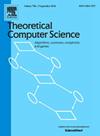在大型锦标赛中寻找和计算小型锦标赛
IF 0.9
4区 计算机科学
Q3 COMPUTER SCIENCE, THEORY & METHODS
引用次数: 0
摘要
我们提出了计算和检测给定锦标赛中的小型锦标赛的新算法。特别是,我们证明了四个顶点上的每场锦标赛(共有四场)都能在 O(n2) 时间内检测到,并在 O(nω) 时间内计数,其中 ω<2.372 是矩阵乘法指数。我们进一步证明,五个顶点上的任何锦标赛(共有 12 场)都能在 O(nω+1) 时间内计数。至于下限,我们证明了对于几乎所有 k 个顶点的锦标赛,检测问题的复杂度并不比针对阶数为 k-O(logk) 的无向小群的相应的、研究得很透彻的计数问题的复杂度更简单。本文章由计算机程序翻译,如有差异,请以英文原文为准。
Finding and counting small tournaments in large tournaments
We present new algorithms for counting and detecting small tournaments in a given tournament. In particular, we prove that every tournament on four vertices (there are four) can be detected in time and counted in time where is the matrix multiplication exponent. We further prove that any tournament on five vertices (there are 12) can be counted in time. As for lower-bounds, we prove that for almost all k-vertex tournaments, the complexity of the detection problem is not easier than the complexity of the corresponding well-studied counting problem for undirected cliques of order .
求助全文
通过发布文献求助,成功后即可免费获取论文全文。
去求助
来源期刊

Theoretical Computer Science
工程技术-计算机:理论方法
CiteScore
2.60
自引率
18.20%
发文量
471
审稿时长
12.6 months
期刊介绍:
Theoretical Computer Science is mathematical and abstract in spirit, but it derives its motivation from practical and everyday computation. Its aim is to understand the nature of computation and, as a consequence of this understanding, provide more efficient methodologies. All papers introducing or studying mathematical, logic and formal concepts and methods are welcome, provided that their motivation is clearly drawn from the field of computing.
 求助内容:
求助内容: 应助结果提醒方式:
应助结果提醒方式:


